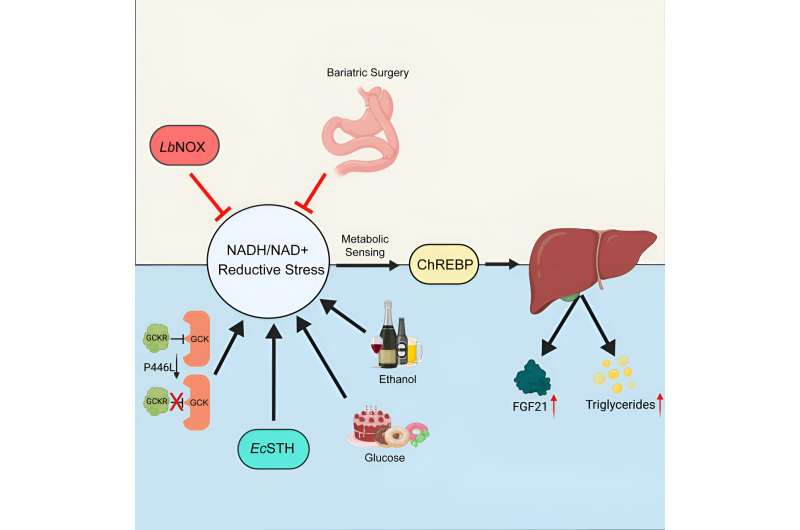This article has been reviewed according to Science X's editorial process and policies. Editors have highlighted the following attributes while ensuring the content's credibility:
fact-checked
peer-reviewed publication
trusted source
proofread
Researchers identify a potential target for reversing poor metabolic traits

During oxidative stress, excess production of reactive oxygen species causes cell and tissue damage.
Reductive stress is the counterpart of oxidative stress and occurs when cells build up too much of a molecule called NADH (nicotinamide adenine dinucleotide + hydrogen), which plays a role in energy production.
New research led by scientists at Massachusetts General Hospital (MGH) indicates that reductive stress causes changes in the liver and circulation, resulting in poor metabolic traits that can contribute to obesity and fatty liver disease.
The work, which is published in Cell Metabolism, was initiated because a common genetic variant in the GCKR gene, which encodes glucokinase regulatory protein, influences many different aspects of metabolism in humans, but the mechanisms involved are unclear.
Glucokinase regulatory protein is predominantly expressed in the liver and controls the activity of an enzyme involved in sensing, storing, and metabolizing glucose.
Experiments revealed that the common variant in GCKR promotes reductive stress in the liver. The researchers discovered that reductive stress (high NADH) promoted by the GCKR variant activates ChREBP, which a transcriptional factor, or a protein that controls the expression of various genes.
The activated ChREBP then proceeds to alter gene expression in the liver to cause numerous undesirable metabolic traits, including elevated fat levels in the liver and blood.
The investigators also found that consumption of large amounts of unhealthy foods or alcohol also likely promotes reductive stress in the liver to trigger this cascade of events. On the other hand, weight loss surgery appears to inhibit this pathway.
"Our work implicates an NADH-ChREBP axis in mediating bad metabolic traits seen in human genetics, obesity, and alcohol and non-alcohol fatty liver disease," says senior author Russell Goodman, MD, DPhil, a physician scientist in the Gastroenterology Division and Endocrine Unit at MGH.
"The research suggests that trying to lower NADH levels is likely to have beneficial metabolic effects in a variety of human diseases."
More information: Charandeep Singh et al, ChREBP is activated by reductive stress and mediates GCKR-associated metabolic traits, Cell Metabolism (2023). DOI: 10.1016/j.cmet.2023.11.010





















